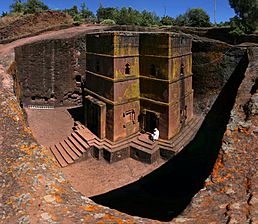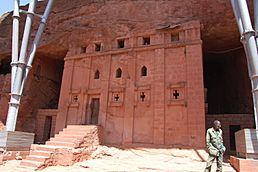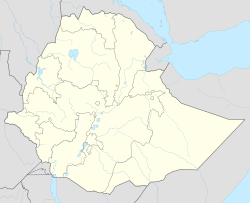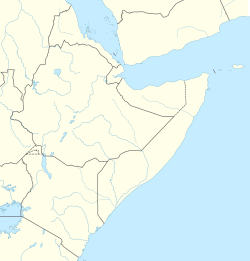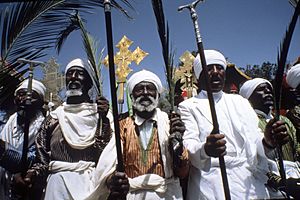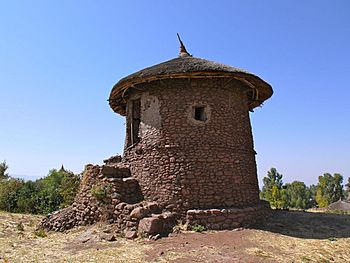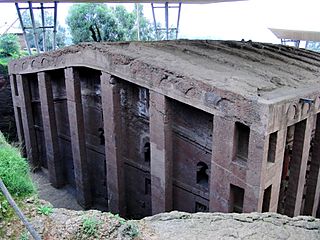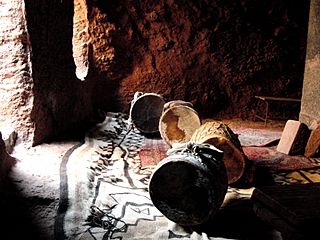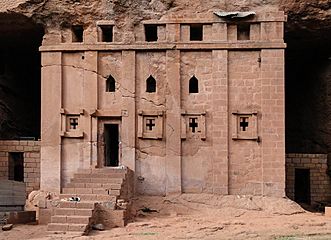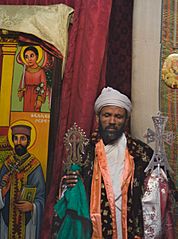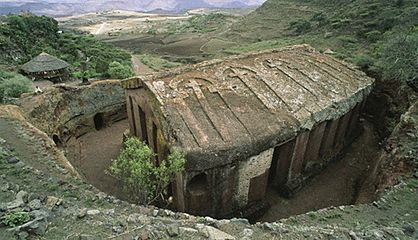Lalibela facts for kids
Quick facts for kids
Lalibela
ላሊበላ
|
|
|---|---|
|
Town
|
|
|
Rock-Hewn Churches from top left: Church of Saint George; Biete Maryam; Biete Medhane Alem; Biete Abba Libanos
|
|
| Country | |
| Region | |
| Zone | North Wollo |
| Population
(2007)
|
|
| • Total | 17,367 |
| Time zone | UTC+3 (EAT) |
Lalibela (Amharic: ላሊበላ, romanized: Lalibäla) is a town in the Amhara Region of Ethiopia. It is famous for its unique rock-cut churches, which are carved right out of the ground. These churches are different from other churches in Ethiopia.
Lalibela is a very important place for the history of Ethiopia. For Christians, it is one of Ethiopia's holiest cities and a major place for pilgrimage (a special journey for religious reasons).
Ethiopia was one of the first countries to become Christian in the 300s AD. The churches in Lalibela were built between the 600s and 1200s. Many people believe they were built during the time of King Gebre Meskel Lalibela (around 1181–1221).
The way the main buildings in Lalibela are set up, and their names, are thought to be a symbol of Jerusalem. Some experts think the churches were built after Jerusalem was captured in 1187 by the Muslim leader Saladin.
Lalibela is about 2,500 meters (8,200 feet) above sea level. The rock-hewn churches became a World Heritage Site in 1978. This means they are protected as a very important cultural place for everyone.
Contents
History of Lalibela
Building the Churches
There are different ideas about when some of the churches were built. Local stories say that before he became king, Gebre Meskel Lalibela was guided by Christ. He was told to build a "second Jerusalem" in Ethiopia.
So, Lalibela (which was once called Roha) was started during the Zagwe dynasty. This was under King Gebre Meskel Lalibela (around 1181–1221 AD). However, it's likely that the churches grew into their current shape over many years. This would have involved several building stages and changes to older structures.
Historian David Buxton thought the work took longer than King Lalibela's reign. He believed it continued into the 1300s. But David Phillipson, a professor of African archeology, thinks some churches were carved much earlier. He suggests they were built as forts or palaces between 600 and 800 AD. This was during the time of the Kingdom of Aksum. He believes Lalibela's name just became linked to them later.
Another local historian, Getachew Mekonnen, says Lalibela's wife, Meskel Kibra, had one church built. This was Biete Abba Libanos, built to remember her husband after he died.
Recent digs in Lalibela have found old pottery and animal bones from 900 AD to 1100 AD. This shows that the area was a normal town before King Lalibela made it a religious center. Also, old carvings of animals were found on cave walls nearby. Later, Christian paintings were added. This suggests the area was still becoming Christian during that time.
Early Visitors and Records
In the 1300s, a religious leader named Abuna Bartolomeo from Egypt visited the churches.
The town's name first appeared on a European map in the 1400s. It was on the Fra Mauro map made in Venice in 1457-59, written as Lalabeda.
In the 1520s, a Portuguese priest named Francisco Álvares visited Lalibela. He was amazed by the churches. He wrote that he worried people wouldn't believe his descriptions because they seemed so incredible. He swore that everything he wrote was true and that there was even more to see.
Later History
During the 1500s, there was a war in Ethiopia. Some records say that Ahmad ibn Ibrahim al-Ghazi burned one of Lalibela's churches. However, historian Richard Pankhurst doubts this. He points out that other historical records from that time don't mention the churches being damaged. If a church was burned, it was likely Biete Medhane Alem. Or, it might have been Gannata Maryam, a church 16 km (10 miles) east of Lalibela.
Another visitor, Miguel de Castanhoso, wrote in 1544 about the churches. He said they were "cut out of the living rock, which are attributed to angels." He also mentioned that when invaders tried to destroy them, they couldn't, even with gunpowder.
In the 1900s, famous people visited Lalibela. In 1968, Mohammad Reza Pahlavi, the Shah of Iran, visited with Emperor Haile Selassie. The next year, Queen Juliana and Prince Bernhard of the Netherlands also came to see the churches.
During the Ethiopian Civil War in the 1980s, Lalibela was sometimes attacked. These attacks made fewer tourists want to visit. By 1990, most visitors were Ethiopians.
In recent years, Lalibela has seen some fighting during the Tigray War. Different groups have taken control of the town at different times. In late 2023, there was more fighting, but the town is now under Ethiopian control.
Architecture of the Churches
The churches in Lalibela show influences from the ancient Aksumite Empire. For example, the church of Biete Amanuel looks like it has stone copies of wooden building parts. You can still see these in some old churches in Tigray and Eritrea.
The doors and windows often have a special shape. They look like the tall stone pillars called stelae found in Aksum. You can see this in the arches of Biete Gabriel-Rufael, the doorway of Biete Maryam, and the windows of Biete Amanuel.
Even though there are Aksumite styles, it doesn't mean the churches were built during the Aksumite era. These styles could have been used much later. This shows a strong connection to Aksumite culture. There are also signs of influences from other Christian areas, like Syria and Egypt.
Many old travelers thought Egyptian builders helped create these churches. However, experts like Stuart Munro-Hay believe that the main building style was Ethiopian. Foreign influence likely added "decorative techniques" (ways to decorate the churches). David Buxton agrees, saying that while there are some Egyptian details, the churches mostly follow local Ethiopian building styles.
The Rock-Hewn Churches
| UNESCO World Heritage Site | |
|---|---|
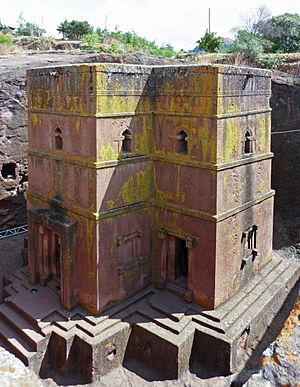
The Church of Saint George, showing its base and walls
|
|
| Criteria | Cultural: i, ii, iii |
| Inscription | 1978 (2nd Session) |
Lalibela is famous worldwide for its churches. They are carved directly out of the earth from "living rock." This is a very special way of building called rock-cut architecture. Most of these churches are believed to have been built during King Lalibela's rule, in the 1100s and 1200s.
Unesco lists 11 churches, which are grouped into four main areas:
Northern Group
- Biete Medhane Alem (House of the Saviour of the World): This church holds the famous Lalibela Cross.
- Biete Maryam (House of Mary): This might be the oldest church. It is said to be a copy of the Tombs of Adam and Christ.
- Biete Golgotha Mikael (House of Golgotha Mikael): This church is known for its art. It is also believed to contain the tomb of King Lalibela.
- Biete Meskel (House of the Cross)
- Biete Denagel (House of Virgins)
Western Group
- Church of Saint George: Many people think this is the most beautifully made and best-kept church.
Eastern Group
- Biete Amanuel (House of Immanuel): This may have been the king's private chapel.
- Biete Qeddus Mercoreus (House of Saint Mercurius): This church might have been a prison in the past.
- Biete Abba Libanos (House of Abbot Libanos)
- Biete Gabriel-Rufael (House of the angels Gabriel, and Raphael): This was possibly a royal palace. It is connected to a holy bakery.
- Biete Lehem ("Bethlehem", meaning "House of Bread" in Hebrew).
There are also other important religious sites nearby. These include the monastery of Ashetan Maryam and Yemrehana Krestos Church. The Yemrehana Krestos Church might be from the 1000s. It was built in the Aksumite style but inside a cave.
The churches are also amazing examples of engineering. They are all connected to water, which comes from wells next to many of them. This water comes from a natural underground system that brings it up to the mountain where the town sits.
Other Features of Lalibela
Lalibela also has an airport (code LLI), a large market, two schools, and a hospital.
Population of Lalibela
According to a 2007 study, Lalibela had a population of 17,367 people. Out of these, 8,112 were males and 9,255 were females.
Climate
| Climate data for Lalibela | |||||||||||||
|---|---|---|---|---|---|---|---|---|---|---|---|---|---|
| Month | Jan | Feb | Mar | Apr | May | Jun | Jul | Aug | Sep | Oct | Nov | Dec | Year |
| Record high °C (°F) | 27.6 (81.7) |
30.0 (86.0) |
30.0 (86.0) |
30.5 (86.9) |
31.0 (87.8) |
28.9 (84.0) |
26.6 (79.9) |
26.2 (79.2) |
26.6 (79.9) |
28.6 (83.5) |
26.7 (80.1) |
26.8 (80.2) |
31.0 (87.8) |
| Mean daily maximum °C (°F) | 23.3 (73.9) |
24.3 (75.7) |
24.8 (76.6) |
24.2 (75.6) |
24.4 (75.9) |
22.8 (73.0) |
20.6 (69.1) |
20.6 (69.1) |
21.3 (70.3) |
22.3 (72.1) |
22.6 (72.7) |
22.8 (73.0) |
22.8 (73.1) |
| Mean daily minimum °C (°F) | 9.0 (48.2) |
10.3 (50.5) |
11.6 (52.9) |
12.0 (53.6) |
12.3 (54.1) |
11.2 (52.2) |
11.3 (52.3) |
11.2 (52.2) |
11.0 (51.8) |
9.9 (49.8) |
8.7 (47.7) |
8.1 (46.6) |
10.6 (51.0) |
| Record low °C (°F) | 2.7 (36.9) |
3.8 (38.8) |
5.0 (41.0) |
8.4 (47.1) |
8.6 (47.5) |
8.6 (47.5) |
7.9 (46.2) |
8.5 (47.3) |
7.0 (44.6) |
5.0 (41.0) |
2.0 (35.6) |
2.3 (36.1) |
2.0 (35.6) |
| Average precipitation mm (inches) | 17.0 (0.67) |
36.0 (1.42) |
68.0 (2.68) |
89.0 (3.50) |
76.0 (2.99) |
124.0 (4.88) |
259.0 (10.20) |
278.0 (10.94) |
174.0 (6.85) |
41.0 (1.61) |
8.0 (0.31) |
10.0 (0.39) |
1,180 (46.44) |
| Source: National Meteorology Agency | |||||||||||||
Gallery
You can also find 3D scans of the Lalibela churches online.
See also
 In Spanish: Lalibela para niños
In Spanish: Lalibela para niños


